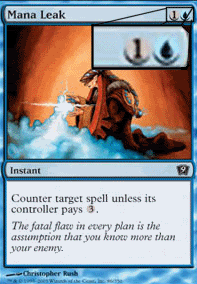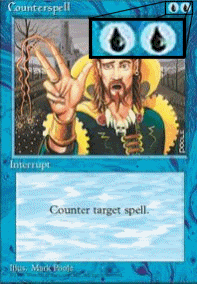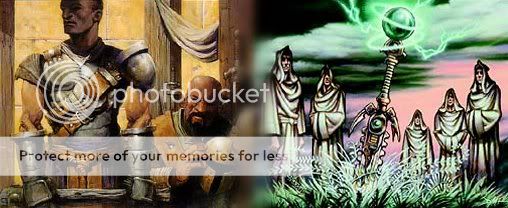
You may have heard the term “synergy” before. Maybe your opponent mentioned something about synergy when he laughed at you for playing Disciple of the Vault and Samurai of the Pale Curtain together in the same deck. Maybe you read an article somewhere about combos and cards that are synergistic with them. Wherever you heard about it first, synergy is an important concept, even a central concept, of the game. You cannot build a decent deck without keeping in mind synergy. Are your card choices synergistic? Let’s find out…
Types of Synergy
www.dictionary.com defines “synergy” as “The interaction of two or more agents or forces so that their combined effect is greater than the sum of their individual effects.” In the game of Magic, this definition can be translated into “when a group of cards’ combined properties/abilities work together in to make a greater effect” – in other words, they help each other out instead of canceling each other out. Take the previous Disciple of the Vault and Samurai of the Pale Curtain anti-combo. The two are obviously not synergistic – the Samurai removes cards that would go into your graveyard from the game, thereby preventing the Disciple from triggering. If you have both in play at once, the former completely negates the latter’s ability, which may not be helpful for you if your deck relies on sacrificing a lot of artifacts.
However, while synergy may seem like a fairly straightforward thing – your cards either work together well, or they don’t – there are several distinct facets to this concept of synergy. The most obvious is he “combo synergy,” or how well individual cards work together, and it ranges from perfect (i.e., an actual combo) to…not so perfect (Disciple of the Vault and Samurai of the Pale Curtain). There are other synergies as well, however – how well your spells work with your mana base, how well different strategies in your deck work together, etc.. We will look at all three of these aspects in this article and see how we can best maximize synergy in each category.
Getting Started
Determining whether or not your cards are synergistic requires that you be able to look at the big picture and figure out the interactions between all of the cards and strategies of your deck. Since doing this all in your head may not be the easiest thing in the world for you, start by looking at the little components and extrapolating from there. I’ve found it helps to lay your deck out in front of you, card by card. Put copies of cards in a pile so that you have one each of every card in your deck out in front of you. Now, separate the cards into types – lands, creatures, instants, sorceries, etc. Once you’ve done this, it will be quite a bit easier for you to look at card interactions, especially among card types and deck themes.
While you’re reading this article, it would help to have a deck in front of you, hopefully one that hasn’t been doing so well lately, to go through. In the event you don’t have such a deck in front of you, don’t worry – I will be giving examples throughout the article.
Combo Synergy
In my last article, I talked about how combos work and how to build decks around them. In the case of synergy, your cards will probably not act as true combos, but you do want to make sure that their effects do not cancel out or affect you inversely. There are a couple of things to look for when determining whether or not card interactions are synergistic: does one card refer to the card type/color/power/toughness of another card, and if so, what happens to the affected card? Does one card affect spells or abilities on the stack, and if so, what happens to them? Do several cards affect you, and what do their cumulative effects do to you?
If any of the answers to the above questions don’t seem good, set the cards involved aside. You will have to take at least one of them out, but which one (or ones) you remove will be determined in part by how those cards interact with the strategies and themes of your deck. Don’t do anything with the cards you set aside yet; we’ll look at them more seriously in other sections.
Let’s do some examples. We’ll start with a single card: Shared Fate. What cards work well with, and so enhance, the ability of the Fate? There are lots of them, so for the purposes of this article, I’ll give you four choices:
A) Manipulate Fate
B) Sensei’s Divining Top
C) Spy Network
D) Scroll Rack
Which of the above cards is the most synergistic with Shared Fate?
D) Scroll Rack: all of the above cards are synergistic with the Fate to at least some degree, and they all include library manipulation to screw with your opponent’s draws, but the Rack is the best consistent manipulator and therefore the most synergistic. “What about Sensei's Divining Top?” you say. Remember, you can use the Rack to put cards on your library you don’t need from your hand, and you can set up a massive mana screw for your opponent this way by putting only spells back every time...of course, at some point, you will probably reach a big pocket of lands and this cycle will break down, but by the time that happens, your opponent will be dead (or something close to it). The key thing to note here is that there is no limit (other than hand size) on the amount of cards you can move around on the top of your library...whereas the Divining Top limits you to three at a time. The aforementioned "big pocket of lands" will probably come quite a bit sooner with the Top than with the Rack, so the Rack is the better choice here.
That was just a warm-up. Let’s look at synergy with a combo – specifically the Yawgmoth’s Will/Shaman’s Trance combo. The deck that uses this combo has a primarily black and red mana base. Which of the following four cards is most synergistic with the combo?
A) Fellwar Stone
B) Hymn to Tourach
C) Millstone
D) Entomb
A) Fellwar Stone: “WHAT?!” you say, “Why not the Hymn or the Millstone?” When considering synergy between cards or between cards and combos, it’s important to take into account mana requirements (see next section). While options B and C are both extremely good with the combo, they won’t do diddley squat for you if your opponent isn’t playing red or black. You need to be able to access whatever colors your opponent is using to get the full benefit from the combo, and Fellwar Stone will allow you to do this. Note, however, that any deck that includes the combo shown above would probably run options A, B, and C.
Mana Synergy
Most things in life require that you use your resources effectively – Magic and mana are no exception. All decks rely on an effective mana base to work well, but what exactly constitutes an effective mana base? And how can your cards and strategies be synergistic with your mana base?
Your mana base should enhance your “spellcasting ability,” as I like to call it – it should accurately reflect the colors and composition of your deck. In mono-colored decks, this is not a problem. I like to follow this rule – if the deck is monocolored and aggro, you can go to as few as eighteen to twenty lands, but you should never go for more than twenty-four unless you have some seriously mana-intensive spells. If the deck is monocolored and control, you can run as few as twenty-three lands, but you should never run more than twenty-seven or so unless your deck needs to sacrifice lots of lands to something. Typically, control decks like more mana than aggro decks (control decks want to have the mana open for answers whereas the aggro decks may not have as many answers), so you should always add more lands in a control deck.
Multicolor decks are much trickier. How many colors do you have, and in what relative proportions are they to each other? There are an almost infinite number of combinations, and this makes it very difficult to give suggestions outside of specific situations, but there are a few general rules of thumb.


Number Two: Proportions are Everything. This is easiest to do with a two-color deck but can be done with any number of colors. For every three cards of a certain color you have, add two lands that produce that color. In the case of multicolor cards, add two corresponding dual lands, painlands, or, if you don’t have lands that produce more than one color, add in one land of each of the multicolor cards’ colors. Artifacts get two lands too, but those lands should produce your deck’s primary color(s). Again, this is easiest with two colors, and it should net you about twenty-four lands for a sixty card deck.
With this in mind, let’s have an example, shall we? You are playing a white, red, and blue control deck (primarily blue, splashing for white and red) which uses a large attacker for the win, but you’re having problems with creature hordes. Evacuation doesn’t cut it – you need a permanent way to deal with an opposing army of weenies, preferably a massive sweeper. Your mana base looks like this:
| Your Mana BaseMagic OnlineOCTGN2ApprenticeBuy These Cards |
|---|
|
4 Volcanic Island 4 Tundra 3 Shivan Reef 8 Island 4 Polluted Delta |
You have the following options. Which is the most synergistic with your mana base?
A) Pyroclasm
B) Starstorm
C) Wrath of God
D) Powerstone Minefield
A) Pyroclasm: right off the bat you know that you will very rarely get the double white required to cast Wrath of God, so that’s out. Powersone Minefield is not a sweeper and could impede your ability to win because it won’t remove your opponent’s blockers. You have a reasonable amount of red mana in your deck, but will you consistently hit the :symr::symr: required to cast Starstorm? Probably not, not with seven red mana sources in a deck of sixty cards. However, you can hit one red mana pretty often, so Pyroclasm should do the trick.
Another thing to keep in mid when dealing with mana synergy is special mana requirements, like with the Yawgmoth’s Will and Shaman’s Trance combo mentioned above. If you know that a card you’re playing will require a color of mana your deck doesn’t support (like running Aether Spellbomb in your Sligh deck), you should either modify your mana base to give you that color or cut the card, depending on how essential it is to the themes of your deck. Speaking of which…
Strategy Synergy
This is the most important and most overlooked part about synergy: do the various parts of your deck work together well, or does the deck try to go in several directions at once? The best decks are streamlined – every card supports the deck’s strategy. In Magic, there are many strategies, but they all fall under one or two of the following:
1) Aggressive: main strategy is to win via attacking with either a few large creatures or a horde of smaller ones, overwhelming an opponent with more damage than they can deal with. Since the deck’s path to victory is almost always with creatures, most of the spells in the deck remove blockers, pump up attackers, or otherwise give support to creatures.
2) Control: main strategy is to win by controlling the board and removing opposing threats while waiting for the deck’s own threats to come out. Relies on board sweepers, card advantage, and occasionally countermagic to keep an opponent in line. All spells in the deck are either threats or ways to deal with them.
3) Combo: main strategy is to win by playing a certain combo and using it to beat the opponent. All cards in the deck either find the combo, support the combo, or protect from an opponent’s answers.
All decks should have threats and answers, but aggressive decks usually have more threats (ways to win) than answers (ways to stop an opponent from winning), and vice versa for control. How do you know which category your deck falls under? Ask yourself how you want your deck to win. Destroy an opponent with a huge army or counter every spell they play? If your answer sounds like the former, you’re playing aggro. If your answer sounds like the latter, you want to play control. Because of this, you want to play cards that support your deck type. Let’s look at the two big deck types again in more detail:
Aggro: the main components of an aggro deck are the creatures, the support, and the utility (a.k.a. “answers”). The support comes in several different forms, depending on the colors played, but usually involves pumping creatures, giving them evasion, trample, or some other ability. Support can also include reanimation spells. Creatures are the deck’s win condition, and they are usually the kind of creatures you want to send into combat, as opposed to creatures that work better on the defense. This means the creatures are big, numerous, or both.
Control: the main components of a control deck are the sweepers, card advantage creators, removal/countermagic, and a win condition – which could be as simple as a good old 62 card deck. The sweepers usually clear the board of creatures but can also remove other problematic card types. The card advantage creators come in the form of card draw, forcing your opponent to discard, or otherwise ensuring you have a numerical advantage over your opponent. The removal is generally in the same form as the sweepers, but targeted (usually). All cards in the deck should work towards shaping the board to your advantage by denying your opponent their win…and anything else, for that matter.

Your options are as follows. Which is the most synergistic with your deck?
A) Leonin Sun Standard
B) Parallel Evolution
C) Glorious Anthem
D) Mirari’s Wake
C) Glorious Anthem: while option D obviously does the same thing as the Anthem and increases your mana production as a bonus, we have to consider strategy synergy and mana synergy here too. First, you are playing a weenie deck, and as such you want to win quickly. The Anthem comes down two turns sooner than the Wake and fits better into your mana curve. That said, option A is an inferior Anthem, and option B is too mana intensive from a green perspective for this deck. Therefore, Glorious Anthem is the way to go.
Well, now that we’re finished, let’s do some review before we go.
Combo Synergy: make sure your individual cards don’t counteract each other. When you have multiple choices for cards, try to choose those that best fit your deck’s strategy.
Strategy Synergy: do all of the different parts of your deck try to achieve the same thing, or all they all pulling in different directions? The three strategies are control, aggro, and combo.
Mana Synergy: make sure your mana base can support the cards you play. When splashing a color, try to make sure you don’t have double or triple color costs on cards of that color.
And that’s all. Many deckbuilding problems come from synergy problems, so hopefully this will be helpful to you next time you build. Remember, the best decks are the decks where the cards work together!
Comments